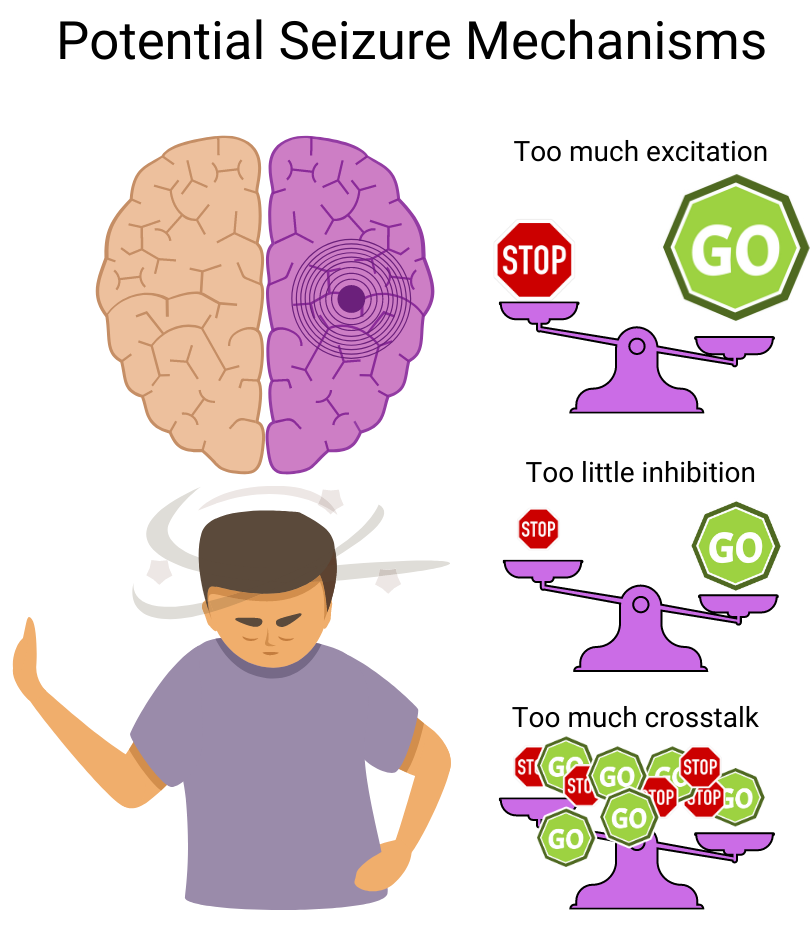#ScienceSaturday posts share exciting scientific developments and educational resources with the KAND community. Each week, Dr. Dominique Lessard and Dr. Dylan Verden of KIF1A.ORG summarize newly published KIF1A-related research and highlight progress in rare disease research and therapeutic development.
KIF1A-Related Research
Epilepsy Overview
This week was the 2022 American Epilepsy Society Meeting, where clinicians, researchers, and patient advocates from across the world convened to discuss challenges and progress in understanding, and treating, epilepsy. So what is epilepsy, and why is it challenging to treat?
Diagnosing seizures
Epilepsy is an umbrella disorder characterized by seizures, periods of excessive or synchronous brain activity. This overactivity disrupts normal function at the site of the seizures, and may spread to other brain regions.
How do we know if someone has had a seizure? Diagnosis requires two observations:
- Did the person experience noticeable symptoms that disrupt quality of life or function?
- Did the person exhibit aberrant brain activity as measured by an electroencephalogram (EEG)?
Both the symptoms and the EEG reading depend on the location and type of electrical dysfunction that person experiences, which is why seizures can be so hard to characterize. Some people may not qualify as epileptic by current screening measures. For example:
- A person may have a detectable seizure by EEG, but experience no obvious symptoms. Are these “asymptomatic” seizures, or is current clinical screening missing out on subtle deficits?
- A person may experience seizure-like symptoms (convulsing, falling, losing consciousness) without an EEG “event” that matches seizure criteria. Is this a non-seizure symptom, or do we need to broaden the scope of “seizure-like” EEG signals? This is a particular concern for the KAND community because many 1hr EEGs don’t detect KAND-specific seizure activity.
To improve this system for KAND patients, we need as much information about symptoms and brain activity. Pooling EEG data across patients may allow us to find signature activity patterns that help us diagnose and manage seizures, which is why we’re so excited about the KAND EEG study at Columbia University.
Causes of Seizures
You can think of neuronal networks as roads filled with cars: By using gas pedals and brakes, cars maintain a certain speed that’s appropriate for the road. Seizures occur when a car is moving too fast on the road, making it harder to control and more likely to cause accidents. Why causes them to lose control like this?
- The gas pedal is stuck: A network may be experiencing too many “go” signals. This can happen because there are too many excitatory neurons, or these neurons are overactive.
- The brakes are broken: A network may not have enough “stop” signals. This can happen because there are too few inhibitory neurons, or these neurons are underactive.
- There’s an oil spill: Electrical signals in the brain usually stay in their “lane” due to a fatty insulation called myelin. When myelin is damaged, electricity from one neuron can spill out to others; this stops some vehicles and causes others to slide faster, but the road is a mess.

Just like with a car, each of these problems is best fixed with its own solution; making an inappropriate repair might not help, or could make things worse, which is why diagnosing the cause is crucial. One of the reasons we chose to partner with NeuCyte is that they can create both excitatory and inhibitory neurons from patient-derived cells, giving us a leg-up when screening for anti-seizure medications appropriate for the KAND community.
As we move toward 2023 epilepsy in KAND is an area of major focus for KIF1A.ORG – we will be working #relentlessly to coordinate our clinical, research, and patient communities to find the best therapies possible.
Rare Roundup
The Rare Disease Translational Center at the Jackson Laboratory
As a small nonprofit organization, KIF1A.ORG relies on our scientific partners: Our Research Network’s dedication to sharing knowledge and tools provides us with unique opportunities to accelerate KAND research. This week we’re highlighting a video from the Rare Disease Translational Center at the Jackson Laboratory, where Cat Lutz has been hard at work helping under-resourced rare disease groups, including KIF1A.ORG. The Jackson Lab has been invaluable for our therapeutic pipeline: They have create 9 genetically engineered human cell lines carrying KAND-relevant mutations, and are developing multiple mouse lines that will help us understand, and treat, KIF1A dysfunction. These resources are a catalyst that will facilitate projects across our Research Network, and we’re grateful to our friends at the Jackson Lab for their generous partnership.

